
Pests and diseases of roses
Encyclopedia
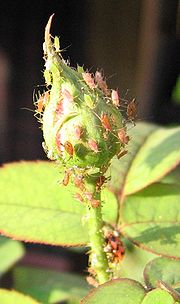


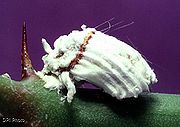

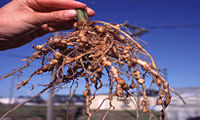
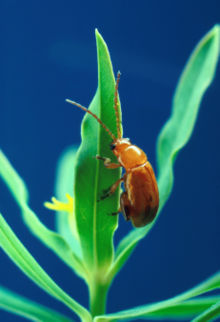
Rose
A rose is a woody perennial of the genus Rosa, within the family Rosaceae. There are over 100 species. They form a group of erect shrubs, and climbing or trailing plants, with stems that are often armed with sharp prickles. Flowers are large and showy, in colours ranging from white through yellows...
s (Rosa sp.) are susceptible to a number of pests, diseases and disorders. A large number of the problems affecting roses are seasonal and climatic. Certain varieties of roses are naturally more resistant or immune than others to certain pests and diseases. Cultivation requirements of individual rose species and cultivar
Cultivar
A cultivar'Cultivar has two meanings as explained under Formal definition. When used in reference to a taxon, the word does not apply to an individual plant but to all those plants sharing the unique characteristics that define the cultivar. is a plant or group of plants selected for desirable...
s, when observed, often assist in the prevention of certain pests, diseases and disorders.
Pests
Insects that affect roses are often considered pests.- Aphids: (Greenfly) (Order HemipteraHemipteraHemiptera is an order of insects most often known as the true bugs , comprising around 50,000–80,000 species of cicadas, aphids, planthoppers, leafhoppers, shield bugs, and others...
Family Aphididae) Macrosiphum rosae – Likely to be found on new shoots and buds, aphids are soft bodied insects 1-2mm long. Often green but occasionally light-brown, and sometimes with wings, they may cover (in a colony) the complete growing tip of the plant. Aphids are most active in spring and summer and multiply at a prodigious rate feeding on the sapSapSap may refer to:* Plant sap, the fluid transported in xylem cells or phloem sieve tube elements of a plant* Sap , a village in the Dunajská Streda District of Slovakia...
of the plant by piercing the plant cells via a proboscisProboscisA proboscis is an elongated appendage from the head of an animal, either a vertebrate or an invertebrate. In simpler terms, a proboscis is the straw-like mouth found in several varieties of species.-Etymology:...
. In large quantities they may seriously retard the growth of the plant and ruin buds. They are particularly damaging to the new shoots with subsequent damage to the emerging leaves which become malformed with much the same appearance as leaf-curl in peaches.
- Two-spotted mite (Spider-mites or Red spider mite) (Order Acari: Family Tetranychidae) Tetranychus urticae – Previously known as red-spider mite these arachnidsSpiderSpiders are air-breathing arthropods that have eight legs, and chelicerae with fangs that inject venom. They are the largest order of arachnids and rank seventh in total species diversity among all other groups of organisms...
prefer the underside of leaves and are difficult to see with an unaided eye. Evidence of their presence is silvering of leaves where the mites have destroyed individual leaf cellsCell (biology)The cell is the basic structural and functional unit of all known living organisms. It is the smallest unit of life that is classified as a living thing, and is often called the building block of life. The Alberts text discusses how the "cellular building blocks" move to shape developing embryos....
. Fine webbing and eggs on the undersides of leaves is further evidence of the presence of Tetranychus urticae.
- ThripsThripsThrips are tiny, slender insects with fringed wings . Other common names for thrips include thunderflies, thunderbugs, storm flies, thunderblights, and corn lice...
(Order Thysanoptera) – Thrips are slim-winged insects 1mm in length, resembling fine black slivers of wood. Preferring light-coloured blooms and often appearing in plague numbers flowers are often left looking bruised and lustreless.
- Rose Slugs (Rose Sawflies)- Sawflies are non-stinging wasps (HymenopteraHymenopteraHymenoptera is one of the largest orders of insects, comprising the sawflies, wasps, bees and ants. There are over 130,000 recognized species, with many more remaining to be described. The name refers to the heavy wings of the insects, and is derived from the Ancient Greek ὑμήν : membrane and...
) in the suborder Symphyta, not flies (DipteraDipteraDiptera , or true flies, is the order of insects possessing only a single pair of wings on the mesothorax; the metathorax bears a pair of drumstick like structures called the halteres, the remnants of the hind wings. It is a large order, containing an estimated 240,000 species, although under half...
). They lay eggs in plant leaves or stems with a saw-like ovipositorOvipositorThe ovipositor is an organ used by some animals for oviposition, i.e., the laying of eggs. It consists of a maximum of three pairs of appendages formed to transmit the egg, to prepare a place for it, and to place it properly...
. There are three species that commonly cause damage to wild or cultivated roses: The Bristly Roseslug (Cladius difformis) is found in Europe, Siberia, and many areas of North America. The larvae is pale green, up to 16 millimetre (0.62992125984252 in) long, and covered with hairlike bristles all over its body. It looks like a catepillar but that term strictly speaking only applies to the larvae of moths and butterflies. It skeletonizes the underside of leaves, with several generations per year. The European Roseslug (Endelomyia aethiops) is found in North America as well as Europe. The larvae is more slug-like (but not slimy), up to 13 millimetre (0.511811023622047 in), and skeletonizes the upper surface of leaves with only one generation per year. The Curled Roseslug (Allantus cinctus) larvae is pastel green on the back, marked on the thorax and abdomen with white dots, and up to 19 millimetre (0.748031496062992 in) long. It frequently coils up like a snake. After skeletonizing entire leaves except the main veins, it pupates in the pith of canes, with up to two generations per year in North America.
- Caterpillars (Order LepidopteraLepidopteraLepidoptera is a large order of insects that includes moths and butterflies . It is one of the most widespread and widely recognizable insect orders in the world, encompassing moths and the three superfamilies of butterflies, skipper butterflies, and moth-butterflies...
) See also List of Lepidoptera that feed on roses – The tortryx (tortrixTortrixTortrix is a genus of moths belonging to the Tortricidae family.-Species:*Tortrix sinapina *Tortrix viridana Tortrix? destructus Tortrix? florissantana...
) moth Lozotaenia forsterana is a prominent pest of roses, although not the sole pest. The caterpillars are green, up to 15mm long, and can be found boring into buds or within curled leaves. When disturbed the caterpillars move swiftly, dropping to the ground on a fine thread. Damage is chewn leaves and flowers and buds with "shot holes".
- Curculio beetles (Family CurculionidaeCurculionidaeCurculionidae is the family of the "true" weevils . It was formerly recognized in 1998 as the largest of any animal family, with over 40,000 species described worldwide at that time...
)
- Japanese beetleJapanese beetleThe beetle species Popillia japonica is commonly known as the Japanese beetle. It is about long and wide, with iridescent copper-colored elytra and green thorax and head...
s (Popillia japonica) - This species, introduced to North America in 1912, is now an endemic pest in the eastern United States. Adult beetles emerge from the ground in early summer and join into swarms for four to six weeks, devouring blooms and skeletonizing foliage on roses and many other garden plants. Japanese beetles can be partially controlled, albeit slowly, by spreading milky sporeMilky sporePaenibacillus popilliae is a soil-dwelling, Gram-positive, rod-shaped bacterium. It is responsible for a disease of the white grubs of Japanese beetles....
bacillus on the lawn areas where the larvae live. The popular pheromonePheromoneA pheromone is a secreted or excreted chemical factor that triggers a social response in members of the same species. Pheromones are chemicals capable of acting outside the body of the secreting individual to impact the behavior of the receiving individual...
-baited traps may do more harm than good by attracting beetles from a wide area.
- Scale insectScale insectThe scale insects are small insects of the order Hemiptera, generally classified as the superfamily Coccoidea. There are about 8,000 species of scale insects.-Ecology:...
s (Order HemipteraHemipteraHemiptera is an order of insects most often known as the true bugs , comprising around 50,000–80,000 species of cicadas, aphids, planthoppers, leafhoppers, shield bugs, and others...
)
- Cottony cushion scale (Order HemipteraHemipteraHemiptera is an order of insects most often known as the true bugs , comprising around 50,000–80,000 species of cicadas, aphids, planthoppers, leafhoppers, shield bugs, and others...
: Family Coccoidea) Icerya purchasiIcerya purchasiIcerya purchasi is a scale insect that feeds on several species of woody plants, most notably on Citrus and Pittosporum. Originally identified in 1878 as a New Zealand located pest of kangaroo acacia, it is now found worldwide where citrus crops are grown.-Life cycle:This scale infests twigs and...
– This scale infestInfestationInfestation refers to the state of being invaded or overrun by pests or parasites. It can also refer to the actual organisms living on or within a host.-Terminology:...
s twigs and branches. The mature female is oval in shape, reddish-brown with black hairs, 5 mm long. When mature the insect remains stationary and produces an egg sac in grooves, by extrusion, in the body which encases hundreds of red eggsEgg (biology)An egg is an organic vessel in which an embryo first begins to develop. In most birds, reptiles, insects, molluscs, fish, and monotremes, an egg is the zygote, resulting from fertilization of the ovum, which is expelled from the body and permitted to develop outside the body until the developing...
. The insect causes little damage but produces copious honeydewHoneydew (secretion)Honeydew is a sugar-rich sticky liquid, secreted by aphids and some scale insects as they feed on plant sap. When their mouthpart penetrates the phloem, the sugary, high-pressure liquid is forced out of the gut's terminal opening. Honeydew is particularly common as a secretion in the Hemipteran...
(frass) that can cause damaging sooty mould.
- California red scale (Order HemipteraHemipteraHemiptera is an order of insects most often known as the true bugs , comprising around 50,000–80,000 species of cicadas, aphids, planthoppers, leafhoppers, shield bugs, and others...
: Family Coccoidea) Aonidiella aurantii – A hard scale, orange to orange-pink, the female covering being less than 1.5mm across. Often in plague numbers this scale infests upper surfaces of foliage causing yellowing, leaf fall, and twig and branch diebackDiebackDieback may refer to a number of plant problems and diseases including:* Forest dieback caused by acid rain, heavy metal pollution, or imported pathogens* The death of regions of a plant or similar organism caused by physical damage, such as from pruning...
. Serious infestations can cause plant death.
- Rose scale (Order HemipteraHemipteraHemiptera is an order of insects most often known as the true bugs , comprising around 50,000–80,000 species of cicadas, aphids, planthoppers, leafhoppers, shield bugs, and others...
: Family Coccoidea) Aulacaspis rosae – Mainly found on the stems and branches of the plant, lack of control will allow the pest to spread to flower stalks and petiolePetiole (botany)In botany, the petiole is the stalk attaching the leaf blade to the stem. The petiole usually has the same internal structure as the stem. Outgrowths appearing on each side of the petiole are called stipules. Leaves lacking a petiole are called sessile, or clasping when they partly surround the...
s. At this point the plant would be stunted, spindly and with a white, flaky crust of scales on the bark. Female Aulacaspis rosae may live for 1 year and may lay 80 eggs each with several overlapping generations living within milliimetres of the original parent.
- Leaf Cutting Bee (Order HymenopteraHymenopteraHymenoptera is one of the largest orders of insects, comprising the sawflies, wasps, bees and ants. There are over 130,000 recognized species, with many more remaining to be described. The name refers to the heavy wings of the insects, and is derived from the Ancient Greek ὑμήν : membrane and...
: Family Megachilidae) Megachile spp. – Leafcutter bees are 6-16mm long and mostly black with bands of light-coloured hair. They chew pieces from the edges of leaves. The pieces are regular in shape, circular or oval. Damage is not often significant.
- Nematodes (Eelworms)(Order TylenchidaTylenchidaTylenchida is an order of nematodes.- List of families :* Superfamily Criconematoidea** Criconematidae** Tylenchulidae* Superfamily Tylenchoidea** Anguinidae ** Belonolaimidae** Dolichodoridae** Ecphyadophoridae** Hoplolaimidae...
: Family Heteroderidae)
- Root-knot nematode Meloidogyne spp.
- See - Root-knot nematodeRoot-knot nematodeRoot-knot nematodes are plant-parasitic nematodes from the genus Meloidogyne. They exist in soil in areas with hot climates or short winters. About 2000 plants are susceptible to infection by root-knot nematodes and they cause approximately 5% of global crop loss...
- symptoms of Meloidogyne infestation in roses is stunting, slow-growth, pale green leaves and wiltingWiltingWilting refers to the loss of rigidity of non-woody parts of plants. This occurs when the turgor pressure in non-lignified plant cells falls towards zero, as a result of diminished water in the cells...
in mild weather.
- Rose chaferMacrodactylus subspinosusMacrodactylus subspinosus is a North American beetle of the family Scarabaeidae. It is one of at least two beetles in this family known as the "rose chafer", the other being the European Cetonia aurata. M. subspinosus occurs from Eastern Canada to Colorado and is considered a pest of many crops...
(Order Coleoptera : Family Scarabaeidae) Macrodactylus subspinosusMacrodactylus subspinosusMacrodactylus subspinosus is a North American beetle of the family Scarabaeidae. It is one of at least two beetles in this family known as the "rose chafer", the other being the European Cetonia aurata. M. subspinosus occurs from Eastern Canada to Colorado and is considered a pest of many crops...
– The rose chafer is common to North America, and emerges in late May to mid June. These beetles form aggregations and feed upon foliage, buds, flowers, and fruit of roses and other ornamentals.
- Metallic flea-beetles (Order Coleoptera: Family Chrysomelidae) Altica spp. – The small, shiny and metallic Altica beetles have thickened hindlegs adapted to jumping, similar to fleaFleaFlea is the common name for insects of the order Siphonaptera which are wingless insects with mouthparts adapted for piercing skin and sucking blood...
s. The insects are 3mm long and chew holes of irregular shapes in young leaves and buds. As the leaves enlarge so do the holes.
Fungal diseases
- Black Spot (Class LeotiomycetesLeotiomycetesThe Leotiomycetes are a class of ascomycete fungi. Many of them cause serious plant diseases.-Systematics:The class Leotiomycetes contains numerous species with an anamorph placed within the fungi imperfecti , that have only recently found their place in the phylogenetic system...
: Family Helotiales) Marssonina rosae syn. Diplocarpon rosae – Marssonina rosae causes black spots on leaves. The spots, which may be as much as 12mm across, are generally circular and have an irregular edge often with a yellow halo. Leaves frequently turn yellow and fall early. Sometimes new leaves are produced, and these may also become affected. Continual defoliation will cause weakness, diebackDiebackDieback may refer to a number of plant problems and diseases including:* Forest dieback caused by acid rain, heavy metal pollution, or imported pathogens* The death of regions of a plant or similar organism caused by physical damage, such as from pruning...
or death of the plant. Some very susceptible species may have stems affected with a considerable reduction in plant vigour.
- Powdery Mildew OidiumOidiumThis article is about a type of fungal spore. For the ascomycete genus, see Oidium . For the fungus that causes powdery mildew on grapes, see Uncinula necator....
sp. – Oidium produces a very fine, powdery coating on the surface of buds and leaves. Significant cases have stems and particularly thorns, infected. Attacks on young leaves and buds will cause deformity with retardation of growth. Infected buds will fail to open. The disease is likely in hot, humid weather, with fungal spores overwintering on the stems and fallen leaves.
- Downy mildewDowny mildewDowny mildew refers to any of several types of oomycete microbes that are obligate parasites of plants. Downy mildews exclusively belong to Peronosporaceae. In commercial agriculture, they are a particular problem for growers of crucifers, grapes and vegetables that grow on vines...
(Class Oomycetes : Family Peronosporaceae) Peronospora sparsa – Peronospora causes purple-red to dark-brown spots on the leavesLeafA leaf is an organ of a vascular plant, as defined in botanical terms, and in particular in plant morphology. Foliage is a mass noun that refers to leaves as a feature of plants....
with irregular margins, however, often angular. StemsPlant stemA stem is one of two main structural axes of a vascular plant. The stem is normally divided into nodes and internodes, the nodes hold buds which grow into one or more leaves, inflorescence , conifer cones, roots, other stems etc. The internodes distance one node from another...
, petiolePetiole (botany)In botany, the petiole is the stalk attaching the leaf blade to the stem. The petiole usually has the same internal structure as the stem. Outgrowths appearing on each side of the petiole are called stipules. Leaves lacking a petiole are called sessile, or clasping when they partly surround the...
s and flower stalks can split and spotted with purple marks. Buds, sepals, petals and calycesSepalA sepal is a part of the flower of angiosperms . Collectively the sepals form the calyx, which is the outermost whorl of parts that form a flower. Usually green, sepals have the typical function of protecting the petals when the flower is in bud...
can be affected and will present purple spots. New growth affected will be deformed. The disease is spread by wind.
- RustRustRust is a general term for a series of iron oxides. In colloquial usage, the term is applied to red oxides, formed by the reaction of iron and oxygen in the presence of water or air moisture...
Phragmidium mucronatum – Rose rust appears as yellow patches on the surface of leaves, with orange pustules of spores underneath the leaf. The fungusFungusA fungus is a member of a large group of eukaryotic organisms that includes microorganisms such as yeasts and molds , as well as the more familiar mushrooms. These organisms are classified as a kingdom, Fungi, which is separate from plants, animals, and bacteria...
is spread by wind. Affected leaves fall prior to healthy ones and plants may be defoliated in serious infections.
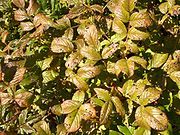
- Anthracnose Sphaceloma rosarum – Spots caused by this fungusFungusA fungus is a member of a large group of eukaryotic organisms that includes microorganisms such as yeasts and molds , as well as the more familiar mushrooms. These organisms are classified as a kingdom, Fungi, which is separate from plants, animals, and bacteria...
originate from a point where leaves are water soaked, usually unnoticeable at first, until they turn black with a very distinct defined edge. As the spots enlarge the centre becomes gray and may fall out resulting in a shot-hole appearance. Defoliation may occur but is often not serious.
- Grey mould (Class LeotiomycetesLeotiomycetesThe Leotiomycetes are a class of ascomycete fungi. Many of them cause serious plant diseases.-Systematics:The class Leotiomycetes contains numerous species with an anamorph placed within the fungi imperfecti , that have only recently found their place in the phylogenetic system...
: Family Sclerotiniceae) Botrytis cineria – On roses grey mould is primarily a disease of the flowers and buds, leaves are infrequently attacked. Infected buds rot on the stem and infection may progress down the stem. On petals botrytis cineria produces pink rings.
- Verticillium wiltVerticillium wiltVerticillium Wilt is a wilt disease of over 300 species of eudicot plants caused by one of two species of Verticillium fungus, V. dahliae and V. albo-atrum. Many economically important plants are susceptible including cotton, tomatoes, potatoes, eggplants, peppers and ornamentals, as well as others...
(Class Incertae sedis: Family Verticillium) Verticillium dahliaeVerticillium dahliaeVerticillium dahliae is a fungal plant pathogen. It causes verticillium wilt in many plant species, causing leaves to curl and discolor. It may cause death in some plants.- External links :* *...
- Sooty moulds Alternaria spp. – Sooty mould appears as black, dry powder on leaves similar to chimney soot. Many sooty moulds grow on the honeydewHoneydew (secretion)Honeydew is a sugar-rich sticky liquid, secreted by aphids and some scale insects as they feed on plant sap. When their mouthpart penetrates the phloem, the sugary, high-pressure liquid is forced out of the gut's terminal opening. Honeydew is particularly common as a secretion in the Hemipteran...
(frass) produced by sap-sucking insect such as aphidAphidAphids, also known as plant lice and in Britain and the Commonwealth as greenflies, blackflies or whiteflies, are small sap sucking insects, and members of the superfamily Aphidoidea. Aphids are among the most destructive insect pests on cultivated plants in temperate regions...
s and soft scales. Alternaria does no direct damage to plants but surface cover of leaves will reduce the plants capacity to photosynthesisPhotosynthesisPhotosynthesis is a chemical process that converts carbon dioxide into organic compounds, especially sugars, using the energy from sunlight. Photosynthesis occurs in plants, algae, and many species of bacteria, but not in archaea. Photosynthetic organisms are called photoautotrophs, since they can...
e and may create an unsatisfactory plant appearance.
- CankerCankerCanker and anthracnose are general terms for a large number of different plant diseases, characterised by broadly similar symptoms including the appearance of small areas of dead tissue, which grow slowly, often over a period of years. Some are of only minor consequence, but others are ultimately...
Leptosphaeria coniothyrium and Cryptosporella umbrina – CankerCankerCanker and anthracnose are general terms for a large number of different plant diseases, characterised by broadly similar symptoms including the appearance of small areas of dead tissue, which grow slowly, often over a period of years. Some are of only minor consequence, but others are ultimately...
s present as small yellowish or reddish spots on bark slowly increasing in size. Leptosphaeria coniothyrium turns brown, increases in size, and may eventually girdleGirdleA girdle is a garment that encircles the lower torso, perhaps extending below the hips, and worn often for support. The word girdle originally meant a belt. In modern English, the term girdle is most commonly used for a form of women's foundation wear that replaced the corset in popularity...
the stem. The tissue within the infection begins to dry out and shrink, presenting a shriveled appearance. If the disease infects only part of the stem, growth above the canker will continue. If it girdles the stem, however, growth will cease and the stem will die.
Viral diseases

- Rose mosaicMosaicMosaic is the art of creating images with an assemblage of small pieces of colored glass, stone, or other materials. It may be a technique of decorative art, an aspect of interior decoration, or of cultural and spiritual significance as in a cathedral...
– This disease is caused by a complex or viruses and is characterized by yellow patterns on the leaves. The patterns vary considerably, ranging between all-over fine blotches to patterns of lines in waves. The patterns may appear on a few or many leaves. Plants are infected by this virus at propagation using infected plant material.
- Rose Wilt – Rose wilt is a complex of virusVirusA virus is a small infectious agent that can replicate only inside the living cells of organisms. Viruses infect all types of organisms, from animals and plants to bacteria and archaea...
es and is referred to as dieback in some areas. The disease can be spread by vectors such as aphids. Symptoms are variable and range from stunted growth to curled young leaves. The soft tissue symptoms are more evident in spring and new leaves will reflex towards their own petioles. The affected leaves are brittle and easily fall from the plant. Fully formed leaves will 'wilt' as if the plant were water stressed.
- Rose Rosette Disease - This disease is caused by a new virus, Rose rosette virus, that is transmitted by the eriophyidEriophyidEriophyidae is a family of more than 200 genera of mites, which live as plant parasites, commonly causing galls or other damage to the plant tissues and hence known as gall mites. About 3,600 species have been described, but this is probably less than 10% of the actual number existing in this...
Rose Leaf Curl Mite Phyllocoptes fructiplilus, which inhabits the shoot tips and leaf petal bases of roses, as well as by grafting but not by seed or many other common vectors. Rose rosette was initially mistaken for a phytoplasma disease; however, heat and tetracycline treatments did not cure the disease showing that a phytoplasma is not the causal agent. Also called Witches’ Broom of roses, it is fatal (average lifespan after infection 22 months) in the shrub Rosa multiflora, commonly found wild or as hedges (and considered a noxious weed in some places). It can also infect other rose species, such as garden rose climbers, miniatures, hybrid teas, floribundas, and antique varieties and is cabable of killing these as well. Roses are the only plants known to be susceptible. Symptoms include mosaic pattern on the leaves, malformed leaves and flowers, elongated shoots that are often red, and sometimes thorn proliferation. The distorted growth may be mistaken for herbicide damage. There is no treatment for the disease, and control is limited to controlling the vector and destroying infected plants. It is reported that the causal agent does not survive in the soil, but can survive in root fragments.
Bacterial diseases

- Crown gall rotAgrobacteriumAgrobacterium is a genus of Gram-negative bacteria established by H. J. Conn that uses horizontal gene transfer to cause tumors in plants. Agrobacterium tumefaciens is the most commonly studied species in this genus...
(Class Alpha ProteobacteriaProteobacteriaThe Proteobacteria are a major group of bacteria. They include a wide variety of pathogens, such as Escherichia, Salmonella, Vibrio, Helicobacter, and many other notable genera....
: Family Rhizobiaceae) Agrobacterium rhizogenes – This disease is characterized by large lumps at the base of the plant stem or on roots. Galls may appear higher on stems as the disease progresses. Galls are soft compared to surrounding plant tissues. The pathogenic bacteriaBacteriaBacteria are a large domain of prokaryotic microorganisms. Typically a few micrometres in length, bacteria have a wide range of shapes, ranging from spheres to rods and spirals...
enter the plant via a wound. If the disease affects the plant whilst it is young the plant may be affected to the degree where it will not produce blooms. All affected plants wiltWiltingWilting refers to the loss of rigidity of non-woody parts of plants. This occurs when the turgor pressure in non-lignified plant cells falls towards zero, as a result of diminished water in the cells...
readily and grow poorly.
Environmental disorders
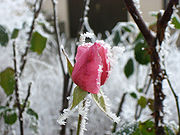
- Frost will destroy fresh growth causing stems and leaves to wilt, turn black and fall away from the plant. Timing pruning to promote growth after the threat of frost is a means to avoid frost damage.
- SalinitySalinitySalinity is the saltiness or dissolved salt content of a body of water. It is a general term used to describe the levels of different salts such as sodium chloride, magnesium and calcium sulfates, and bicarbonates...
will present in roses as limp and light brown leaves with dry leaf margins. Soil may require testing to determine salinity levels. Symptoms will present if salinity is greater than 1200 parts per million.
- HerbicideHerbicideHerbicides, also commonly known as weedkillers, are pesticides used to kill unwanted plants. Selective herbicides kill specific targets while leaving the desired crop relatively unharmed. Some of these act by interfering with the growth of the weed and are often synthetic "imitations" of plant...
Damage – Overspray or soil leaching of herbicidal sprays can present with several symptoms: :Prolonged exposure to overspray of glyphosate will cause yellow leaves and new leaves will be small and elongated. Hormone weed sprays (e.g. 24-D & 245-T) may cause grotesque new growth with thin twisted leaves and distorted buds. Plants may die in severe cases. Pre-emergent herbicides contacting the plants' rootRootIn vascular plants, the root is the organ of a plant that typically lies below the surface of the soil. This is not always the case, however, since a root can also be aerial or aerating . Furthermore, a stem normally occurring below ground is not exceptional either...
system via the soil will cause yellowing foliage. Effects of soil borne herbicide may take several years to clear.

